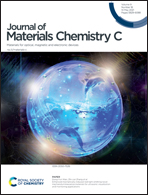First-principles study of bilayer hexagonal structure of SN2 nanosheet: a highly stable non-metal platform for the quantum anomalous Hall effect†
Abstract
Although layered metal dinitrides (MN2) have been proposed as the cousins of transition-metal dichalcogenides, the non-MoS2-type geometries are found to be more favourable in two-dimensional (2D) MN2 nanosheets. In this work, motivated by the recent synthesis of the SiO2-like SN2 solid, we perform a comprehensive first-principles study on the bilayer hexagonal structure (BHS) of the SN2 nanosheet. It is found that the BHS-phase is the real lowest-energy structure of the 2D SN2 form, which possesses robust dynamical, mechanical and thermal stabilities. The BHS-SN2 nanosheet is a quasi-direct semiconductor, whose top valence band is quite flat. As a result, Stoner ferromagnetism could be induced by hole doping, which causes half-metallic or ferromagnetic metallic behaviour depending on the hole concentration. Moreover, at a doping level of one hole per cell, the doped BHS-SN2 nanosheet exhibits a spin-polarized semi-metallic feature without considering the spin–orbit coupling (soc). After the inclusion of the soc effect, this system exhibits quantum anomalous Hall (QAH) insulating behaviour with a non-trivial band gap of 18 meV. The non-trivial topology is characterized by a non-zero Chern number of C = 1, which is confirmed by a quantized Hall conductance and a single gapless edge state in the bulk gap. The QAH behaviour is not only present in the doped system, but also appears in the P-substituted BHS-SN2 derivative, i.e. the PS3N8 nanosheet. The non-trivial gap increases to 26 meV when the PS3N8 nanosheet is supported on a fluorographene substrate, which facilitates the experimental observation of QAH effect. Our study demonstrates that intriguing QAH behavior can emerge in the system composed solely of light non-metal elements, which provides a new avenue in the design of novel topological materials.



 Please wait while we load your content...
Please wait while we load your content...